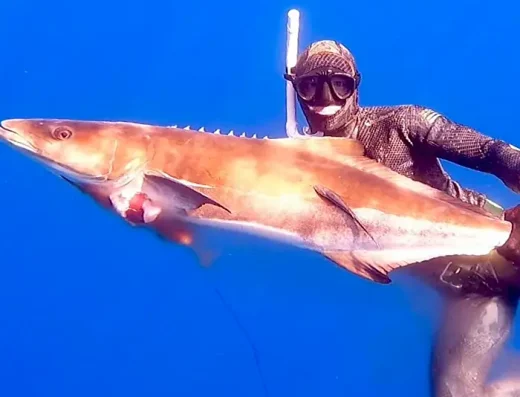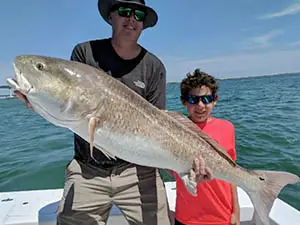Wanchese Fishing Charters
Wanchese fishing charters work the Oregon Inlet, Roanoke Sound, and the offshore Gulf Stream for red drum, speckled trout, tuna, mahi, and billfish.
Top Rated Charters in Wanchese
TrustedFish connects anglers with proven local captains in Wanchese, North Carolina —no commissions, no pay-to-play listings, no BS. Every charter on our platform is invite-only, vetted for skill, local knowledge, and reputation. If they’re listed, they’ve earned it.
Wanchese, NC Fishing Guide
Wanchese sits at the southern end of Roanoke Island, giving anglers direct access to both inshore and offshore waters. Most trips here run out of the Oregon Inlet Fishing Center, which is only a short ride through the inlet before you’re on the grounds. Half-day charters generally stay inside the sounds, where grass flats, deep channels, and oyster beds hold red drum, speckled trout, bluefish, and flounder. Full-day trips can push offshore, targeting the Gulf Stream for tuna, mahi, and billfish, or work wrecks and reefs for king mackerel and amberjack. Specialty trips include cobia in the spring, marlin tournaments in summer, and bottom fishing the deeper wrecks year-round.
The run distances depend on the target. Inshore trips may travel only a few miles from the launch, staying in Roanoke or Pamlico Sound, while offshore boats run 30 to 50 miles to reach the Gulf Stream edge. Techniques vary with the waters: light tackle and fly rods shine in the shallow sound waters, while trolling spreads, live bait rigs, and vertical jigging are staples offshore. Nearshore wrecks are often fished with bottom rigs, cut bait, or jigs, producing steady action.
Seasonality drives the fishery in Wanchese. Spring and fall see strong red drum and speckled trout bites inside, with cobia pushing through Oregon Inlet. Summer means offshore action for dolphin, wahoo, and billfish, while winter sees stripers moving through the area when conditions line up. The unique geography of Wanchese allows captains to adjust quickly, shifting from soundside casting to deep-sea trolling depending on the day’s weather and tide. With easy access to both sound and sea, Wanchese fishing remains one of the most versatile options along the Outer Banks.
Fishing Seasons in Wanchese
Spring (March–May)
Spring fishing in Wanchese focuses on inshore waters, where warming temperatures bring red drum and speckled trout into the grass flats and creek mouths. Cobia start appearing off Oregon Inlet by late May, and many captains run half- to full-day trips specifically for them, often sight-casting with bucktails and live bait. Offshore, yellowfin tuna are the prime target, and trolling spreader bars and cedar plugs produce consistent hookups. Sound trips often use popping cork rigs for specks and drum, and the mix of options makes spring one of the more diverse fishing seasons here.
Summer (June–August)
Summer is peak season in Wanchese, with offshore boats chasing mahi, wahoo, tuna, and blue marlin along the Gulf Stream. These trips can be long runs, but the action is steady, with trolling being the go-to tactic. Inshore, anglers find speckled trout and puppy drum along the grass lines, with topwater lures producing great early morning bites. Flounder become more active on nearshore wrecks, and many charters offer half-day bottom fishing for them. The combination of inshore casting and offshore trolling makes summer fishing especially popular with families and serious anglers alike.
Fall (September–November)
Fall brings cooler water and some of the year’s best inshore fishing. Big bull red drum migrate through Oregon Inlet, often caught by anchoring near shoals and soaking cut mullet. Speckled trout fishing peaks, with soft plastics and live shrimp rigs producing heavy numbers. Offshore, wahoo fishing hits its stride, with high-speed trolling along temperature breaks paying off. King mackerel also move in strong, hitting live baits around wrecks and nearshore reefs. Fall weather can shift quickly, but when conditions line up, Wanchese delivers excellent mixed-bag fishing.
Winter (December–February)
Winter slows the offshore action, though hardy captains still chase tuna and bottom species when weather allows. Inshore, stripers become the main draw, though their runs vary year to year. When they show, trolling bucktails or casting swimbaits around bridges and channels is productive. Some speckled trout remain in the deeper creeks, and a few black drum linger on the flats. Winter trips are typically shorter and more weather-dependent, but they can produce quality fish for anglers willing to brave the cold.
Gamefish in Wanchese
- Red Drum – 18–50 lbs. Caught in Roanoke Sound grass beds in spring and fall, often on cut mullet or topwater lures.
- Speckled Trout – 1–6 lbs. Found in soundside creeks and grass flats, best from spring through late fall using popping corks and plastics.
- Cobia – 20–80 lbs. Migrates past Oregon Inlet in late spring, sight-cast with bucktails or live eels
- Yellowfin Tuna – 20–70 lbs. Offshore in spring and early summer, caught trolling spreader bars and cedar plugs.
- Mahi-Mahi – 5–30 lbs. Found offshore in summer, holding around weedlines and floating debris, hit fast-trolled ballyhoo
- Blue Marlin – 150–500+ lbs. Gulf Stream target in summer, hooked while trolling large ballyhoo and artificial lures.
- Wahoo – 20–70 lbs. Fall offshore fish, often taken on high-speed trolling near temperature breaks.
- King Mackerel – 10–40 lbs. Caught nearshore and offshore wrecks in fall, using live bait slow-trolled around structure
Wanchese Fishing FAQs
What are the main launch points in Wanchese?
Most charters run out of Oregon Inlet Fishing Center, though smaller boats may launch directly from Wanchese Harbor or ramps on Roanoke Sound.
How long are typical Wanchese fishing trips?
Half-day trips last 4–6 hours and usually stay in the sounds or nearshore wrecks, while full-day offshore charters run 8–12 hours to reach the Gulf Stream.
Do charters provide gear and bait?
Yes, Wanchese captains supply rods, reels, tackle, and bait. Many also provide fish cleaning back at the dock.
Is a fishing license required for visitors?
No, anglers fishing on a licensed charter are covered under the captain’s license. If fishing on your own from shore or a private boat, you’ll need a North Carolina Coastal Recreational Fishing License.
What’s the best time of year to fish in Wanchese?
Spring and fall are best for inshore drum and trout, while summer offers the strongest offshore action for mahi, tuna, and billfish. Winter fishing depends heavily on striper availability.
What techniques are most common?
Light tackle casting, popping cork rigs, and fly fishing are popular in the sound. Offshore boats rely on trolling with ballyhoo, spreader bars, and lures, plus bottom rigs on wrecks
Which species are most popular for family trips?
Inshore trips for trout, drum, and bluefish are family-friendly, while nearshore wreck fishing for flounder and mackerel provides steady action without long runs.
How many people can go on a charter?
Most inshore boats carry 4–6 anglers, while offshore sportfishing boats typically hold up to 6 passengers.
Are night or specialty trips available?
Yes, some captains offer nighttime drum and striper trips, cobia sight-fishing in spring, and offshore tournament charters in summer.


